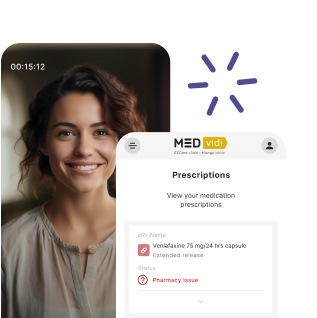Highlights
- Attention deficit hyperactivity disorder (ADHD) has three types: predominantly inattentive, predominantly hyperactive/impulsive, and combined.
- Combined type is the most common of the subgroups of ADHD.
- Treatment might vary according to ADHD type and severity. Behavioral therapy and medication are the most common options.
You’ve always known about attention deficit hyperactivity disorder (ADHD); maybe you have this condition or know somebody who does, but weren’t aware that there are different ADHD types.
So why does this matter? Believe it or not, it is essential to know what type of ADHD you have because it will help you to know what coping strategies to use to feel better; you’ll find out more about it below. Before that, though, let’s do a quick-fire review of the basics of ADHD.
The right diagnosis is key

ADHD is a common mental health condition, and although it starts in childhood, in some people, it continues into adulthood or might only be diagnosed later in life; it is estimated to affect
In 2013, the diagnosis principles changed to include the following types of ADHD:
- Predominantly inattentive
- Predominantly hyperactive/impulsive
- Combination of the above
This article will focus on the combined type of ADHD.
What Is Combined Type ADHD?
As the name “combined type ADHD” suggests, the person with ADHD has both low attention and high energy symptoms. This is an overly basic explanation, and specific criteria need to be met, which we’ll run through in detail.
How Common Is It?
The combined subtype of ADHD is by far the most common presentation of attention deficit hyperactivity disorder, with

How It Differs From Other Types
The first step is processing how an ADHD combined presentation differs from those with mostly inattentive or hyperactive-impulsive symptoms.
Let’s look closely at how the predominantly inattentive and hyperactive/impulsive types are diagnosed in adult ADHD according to the Diagnostic and Statistical Manual
|
Diagnosing predominantly inattentive ADHD type |
Diagnosing ADHD predominantly hyperactive/impulsive type |
|
Five or more of the nine symptoms below, present for six months:
|
Five or more of the nine symptoms below, present for six months:
|
If you notice several similar symptoms, see a healthcare provider for online ADHD diagnosis and treatment.
Diagnosing ADHD Combined Type
Now that you know what is needed to confirm predominantly inattentive and hyperactive-impulsive ADHD, how to diagnose ADHD combined type? We’ve hinted at it before; it means that the person has to present a mix of both low attention and high activity.
There is also a rating scale on how severe the ADHD symptoms of combined presentation are:
- Mild combined ADHD: There are the minimum number of symptoms needed for diagnosis, for example, five inattentive and five hyperactive-impulsive symptoms. Also, work and social life are only slightly impacted.
- Moderate combined ADHD: Somewhere in between.
- Severe combined ADHD: Many more symptoms are present than those required to make the diagnosis, or there is significant ongoing trouble and dysfunction at work and home.
So, what would this look like in real life?
Symptoms of Combined ADHD
You might be experiencing a mixture of the signs listed below. Firstly, some inattentive symptoms, which are due to difficulty paying attention, present as:
- Making careless mistakes
- Overlooking essential details and having poor work quality
- Being easily distracted by things around you
- Taking extra mental effort to get through tasks
- Not being ‘present’, daydreaming
- Not completing tasks and getting sidetracked
- Being messy and having a disorganized work presentation
- Repeatedly being late or missing appointments
- Losing important items like reading glasses, keys, or mobile phones
- Avoiding boring or complicated tasks like preparing reports, completing forms, reviewing lengthy papers
- Neglecting paying bills, shopping, returning calls, or household chores
- Not getting around to routine health checks or car services
- Having poor time management
- Failing to meet deadlines
Next, hyperactivity/impulsivity might
- Not being able to sit still
- Being restless, agitated, twitchy, or jumpy
- Being loud, overbearing, and prone to excessive talking
- Interrupting conversations
- Not being able to wait in queues
- Being ‘on the go’, and others are unable to keep up
- Using other people’s things without asking permission
- Engaging in irresponsible behavior
- Saying
inappropriate[3] things at inappropriate times - Being accident prone
If this sounds like you, and you haven’t been diagnosed with adult ADHD, why not take a free, 5-minute screening test?
Causes & Risk Factors
You might have other thoughts, for example, about why you would have a combined presentation of ADHD in the first place. Let’s look at the risk factors and other contributing causes.
First, the biological family members of a person with attention deficit hyperactivity disorder have a higher risk of also having it because it runs in DNA. A concrete example of this is that a sibling of a person with ADHD has a 9 times higher risk of having ADHD than the sibling of someone who doesn’t have this condition. Also, studies in adoptive families show that genes trump a shared environment with regard to ADHD risk.
In addition, evidence suggests that there are also
- Mothers smoking or drinking alcohol during pregnancy
- Premature delivery
Low birth weight[5] - Higher levels of family conflict
- Exposure to toxins and heavy metals like lead and mercury
- Exposure to chemicals such as pesticides
- Excessive screen-based media use
- Poor sleep-wake cycles
- Childhood stroke
- Brain injury
Next, we’ll discuss how the combined presentation of ADHD might negatively impact everyday life.
Challenges of People With Combined Type ADHD
Some struggles of combined ADHD relate to difficulty concentrating and can manifest as poor work and learning performance. The result might be a failure to climb the corporate ladder, disciplinary hearings, and job hopping. Neglecting everyday essential activities can result in a poor credit rating, unhealthy diets and personal hygiene, and household clutter.
People with the combined subtype of ADHD often have significant trouble ‘fitting in’ and are frequently
Another challenge is that other mental health conditions often co-occur with ADHD and impact quality of life. The most common is substance use disorder (SUD), followed by mood disorders (depression), anxiety disorders, and personality disorders; another associated condition is oppositional defiant disorder (ODD). These need to be considered in any person with ADHD when seeking treatment.
So, how do you tackle these challenges? Let’s start with some coping strategies you can practice daily.
10 Self-help Tips for Managing Combined ADHD
- Make lists and use organizational tools like calendars, diaries, and planners.
- Use alarms and set reminders.
- Take regular breaks.
- Limit environmental distractions by working in a quiet, private environment free of clutter and electronic devices.
- Break tasks into smaller, manageable steps.
- Stay physically active, as this
improves focus[6] anddecreases anxiety[7] . - Ensure a healthy sleep pattern to
ensure better focus[8] . - Practice mindfulness to
regulate emotions[9] and increase focus by paying attention to how you feel in the moment without judgment. - Use stress balls, fidget toys, or chew gum if you’re restless.
- Join ADHD support groups.
These tips should be the baseline interventions for every person with ADHD, but if you are still having problems at work and home, you should consult with a healthcare provider for personalized ADHD treatment.

Treatment for the Combined ADHD in Adults
Treatment options for combined presentation of ADHD might involve therapy, medication, or both.
Medications for ADHD Treatment
Healthcare professionals often prescribe medication as the mainstay of the treatment plan.
In the case of co-existing anxiety disorders and depression, a specific mental health treatment such as antidepressants may also be helpful.
Behavioral Interventions
Cognitive-behavioral therapy (CBT) is a talk therapy that helps you change how you think, feel, and act. By identifying unwanted thoughts and emotions, you can process them and increase positive behaviors.
Other helpful behavioral treatments might include family or relationship therapy, where everyone will learn about ADHD, its effect on behavior, and how to manage it and encourage and reinforce change.
Summing Up
It is important to get a proper diagnosis, including the type and severity of attention deficit hyperactivity disorder as this may influence the treatment options that your healthcare provider incorporates into your personalized plan. Book an appointment at MEDvidi to go through a detailed symptom assessment online within 24 hours.
FAQ
Is ADHD combined type a disability?
“Americans with Disabilities Act (ADA): A disability is a physical or mental impairment that substantially limits one or more major life activities.”
ADHD combined type is not, by definition, a disability. It is a mental health disorder that falls under the category of brain development (neurodevelopmental) disorders. However, in severe cases that permanently affect the person’s ability to learn, work, concentrate, or socialize, ADHD combined type can be classified as a disability. This might qualify the person for adjusted or adapted work or learning conditions.
What are the struggles of combined ADHD?
What are the strengths of people with ADHD combined type?
Hyperactivity and impulsivity can be seen as
What are the symptoms of combined ADHD in women?
Women are more likely to present with inattentive symptoms than hyperactivity, which is not as easy to recognize and might result in a delayed diagnosis. This increases the risk of poor self-esteem, difficult relationships, and mental disorders like anxiety and depression.
What is the best medication for combined type ADHD?
What is the link between ADHD and oppositional defiant disorder?
Comorbid oppositional defiant disorder occurs in











